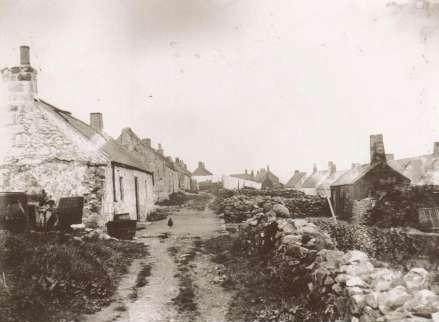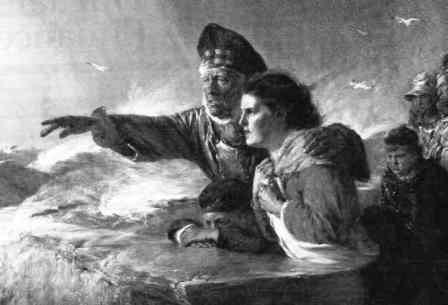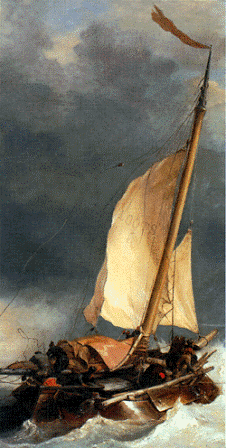
So Near yet so Far (1914) |
A ketch with a crew of three foundered on rocks near Portlethen in December of this year. The vessel was first observed by the Stonehaven coastguards at about 1pm, and at that time, although it appeared to be labouring slightly, it was making good headway before the prevailing east-south easterly gale. Passing Muchalls the ketch was seen to be in difficulties but it was decided that there didn’t appear to be immediate cause to render assistance.
It was when the vessel was approaching Portlethen at around 3pm that some fishermen watching from the safety of the shore saw that there was something seriously amiss. The boat was steadily being driven towards the lee-shore and the watchers quickly determined that she was rudderless and beyond control. There were three men on deck doing all that they could to keep the small craft off the rocks but it was soon obvious that disaster would overtake them.
 The news had quickly spread and nearly all the
inhabitants of Portlethen Village had gathered on the rocks, some of
whom were trying to render assistance and shout instructions to the crew
of the ketch which was being driven ashore. George Craig, a local
fisherman, held up a white sheet with a message to the crew directing
them to attempt to head for a small gully which might offer them some
respite and time to escape from the boat on to the rocks. The three men
visible on deck picked up the signal and used all means possible to make
for this haven which, although perilous, offered the only small hope of
reaching dry land alive.
The news had quickly spread and nearly all the
inhabitants of Portlethen Village had gathered on the rocks, some of
whom were trying to render assistance and shout instructions to the crew
of the ketch which was being driven ashore. George Craig, a local
fisherman, held up a white sheet with a message to the crew directing
them to attempt to head for a small gully which might offer them some
respite and time to escape from the boat on to the rocks. The three men
visible on deck picked up the signal and used all means possible to make
for this haven which, although perilous, offered the only small hope of
reaching dry land alive.
It was a brave fight for life and it was nearly crowned with success. The vessel, handled with wonderful seamanship under terrible conditions and against overpowering odds, just failed to reach safety. Carried on the crest of a heavy sea, the ketch crashed with great force onto the rocks at the north side to the entrance to the gully. Those on shore, only fifty yards away, shouted to the two men who were standing on the bow to jump however just as they were about to do this a heavy wave caught the vessel and she heeled over and sank almost immediately.
As the little craft went down a cloud of coal dust rose up from the spot where it had disappeared, and this suggested that it was coal laden and was in all likelihood one of the small sailing traders that plied the east coast on a regular basis.
 Andrew Wood, a local fisherman from Portlethen recounted
this incident as it happened. He recalled that the Portlethen boats had
a narrow escape themselves making harbour just before the strong breeze
developed into a full gale. At 1.30 the sea rose, and huge waves were
being dashed about the rocks near the village. About 3 o’clock he
observed the ketch coming from the south and that she was “well in” and
appeared to be in difficulties. Heavy seas were breaking over the vessel
and her sail was in ribbons. The fishermen from the village assembled on
the shore and made ready to render assistance, shout instructions and
give signals.
Andrew Wood, a local fisherman from Portlethen recounted
this incident as it happened. He recalled that the Portlethen boats had
a narrow escape themselves making harbour just before the strong breeze
developed into a full gale. At 1.30 the sea rose, and huge waves were
being dashed about the rocks near the village. About 3 o’clock he
observed the ketch coming from the south and that she was “well in” and
appeared to be in difficulties. Heavy seas were breaking over the vessel
and her sail was in ribbons. The fishermen from the village assembled on
the shore and made ready to render assistance, shout instructions and
give signals.
The signals were understood and the instructions given by the fishermen were being carried out when a huge wave struck the boat on the boom, which sent the bow around in the opposite direction. He saw that there were two men standing on the front of the bow at the time that the small craft was labouring heavily and the waves were mercilessly driving her towards the shore when she struck the Lang Crag rock. For a second she was high and dry on the rock and instructions were shouted to the crew to jump ashore however the next wave completely covered her, washing the vessel off the rock and within a minute she had sunk. After that there was no sign of the crew.
Initially very little wreckage was washed up and Mr Wood believed that most of it was carried out on the ebb tide, it being very strong at that particular time. In his opinion the craft had broke in two, one part being smashed to pieces and the other portion carried away by the strength of the ebb tide. The following day however, saw some flotsam and jetsam being washed up on the coast and from this it was finally identified that the vessel was one that went by the name of “Warcry”.
In conclusion to this shipwreck I am left with one question – did this wreck occur at the rocks known as Lang Crag (which is stated in Mr Wood’s account) which is nearer Downies than Portlethen or did it happen at Land Crag, east of Portlethen harbour and directly in sight of the village. The descriptions given and the topography of both places means that I can’t reach a definitive conclusion of where exactly this boat sank, however given that most of the population of Portlethen Village turned out to watch this incident it seems more likely to have occurred at Land Crag, near to Portlethen shore.